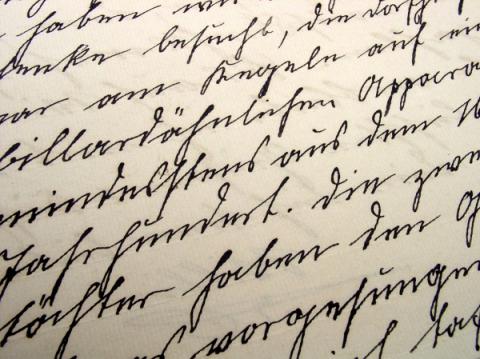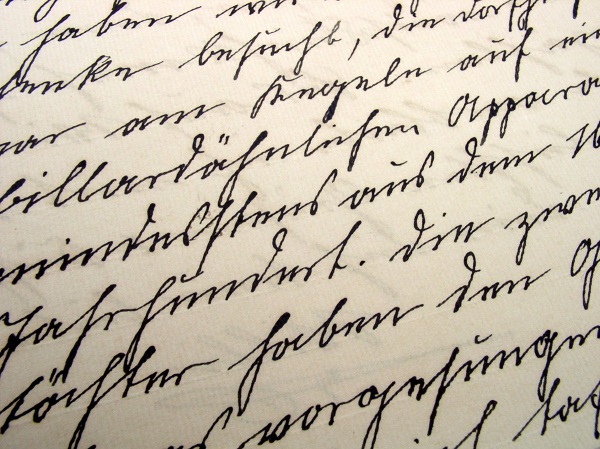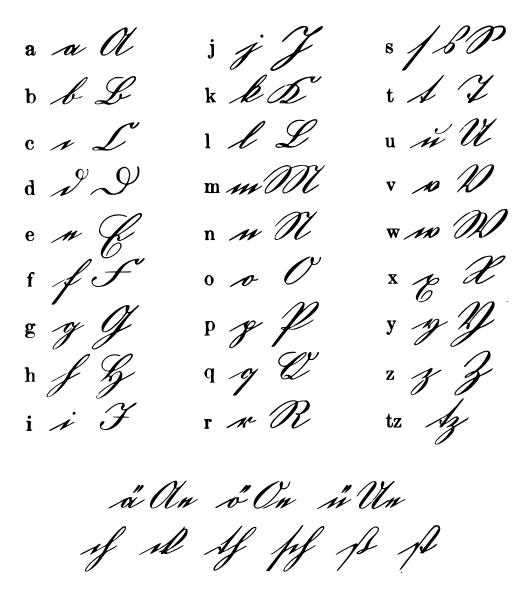But What Does It SAY? How Three Historical Scripts Supercharged My Genealogy Research – Part 1

By its very nature, genealogy research involves digging through historical records—many of which will be handwritten. The overwhelming majority of handwritten material in the past was written using cursive handwriting, and the ability to read them can be paramount for reconstructing the histories of our families. Although it may be falling out of favor today and some of today’s young people are no longer being taught to write or even read it, any historian or historical researcher needs to be able to do so. For genealogists, the ability to read cursive handwriting is simply indispensable, yet often comes with significant additional complications.
While reading handwriting in our native language is quite straightforward, as genealogists we are often confronted with handwritten documents in our ancestors’ native languages rather than our own. This can present extreme challenges, but can also provide exciting rewards—as in my own research. My journey of acquiring proficiency in three historical writing styles has been a remarkable one, filled with Herculean effort but also with astonishing surprises. The exciting insights I have gained about my family’s history and those of my clients have truly made it worth every bit of effort.
The Challenges of Foreign Handwriting
Reading handwritten material in a foreign language takes special skills. To see this, think for a minute about reading handwriting in your native language. Since you’re already quite familiar with the words in your own language, you often already know what word to expect when you get to a word you can’t read. If you are unsure of what a poorly-written word says, it is usually possible to guess at it from the context. Conversely, reading printed material in a foreign language is also relatively easy. When you encounter a word you don’t understand, you can look it up in a dictionary to determine its meaning—provided you have an understanding of how words change given the grammatical peculiarities of whichever language you’re reading in.
In contrast to these two situations, reading handwritten material in a foreign language can be very challenging. When you see a word you can’t read, you probably will not know what word to expect. In cases like this, it is much more difficult to figure out what word to look up in the dictionary. The ability to read handwritten material in any foreign language takes a lot of patience, trial, and error. Yet some languages present even greater obstacles than this.
While Romance and western Slavic Languages use the same cursive writing system as English, many other languages do not. Most Jewish families present in the United States arrived here during the period between approximately 1880 and 1920 from places like Austria, Poland (controlled by the Russian Empire until 1918), Lithuania, and Russia. In places like these, many official records will be in German or Russian—two languages whose handwriting presents special difficulties. Other records and documents may be in Hebrew, which presents its own set of challenges.
Kurrent-What?
Today’s German is written in letters virtually identical to English—both in print and cursive. Although there are a few exceptions such as ö or ß, most German letters are exactly the same as English letters. However, German was written very differently prior to 1940. Technically, it did use the same alphabet—unlike Hebrew, Arabic, or Russian which use altogether different ones. German used the same letters prior to 1940 as it does now, but they had very different forms than what we are used to.
Many readers will be familiar with pre-1940 German print, which closely resembles “Gothic” or “Old English” fonts found in Microsoft Word. It looks somewhat similar to this (although not exactly). Reading this kind of material is essentially like reading text in an alternate typeset. A few letters or letter combinations may be tricky (for example, A, U, s, f, and ck), but it is generally possible to read older printed material in German with virtually no special training—even if you don’t know German.
Pre-1940 German cursive writing, however, is an entirely different story. This type of writing is known as “Kurrentschrift”; between approximately 1910 and 1940 it was called “Sütterlin” or “Sütterlinschrift.” Although the actual letters of the alphabet are still the same as in English, Kurrentschrift letters look completely different from English or modern German ones.
Not in official use since 1940 and not taught in German schools since the 1970s, the ability to read it is rapidly disappearing. The differences between Kurrentschrift and modern German handwriting are so profound that it is difficult or impossible to read it without special training, even for modern Germans. In fact, in recent years it has become an increasingly serious problem to find German postmen who can deliver mail addressed by the older generation.

Beginning to Read Kurrentschrift
In my personal research, I had uncovered many family records that were partly or completely in Kurrentschrift. I had already gotten so far in my research and was extremely curious what they said. I already knew German, so I could not think of any good reason why I shouldn’t be able to access the information hidden in these records. Not one to back away from a challenge, I decided to train myself to read it.
I began by using tutorials available on the Family Search website. The tutorials gave me basic information on how each letter was formed and provided alphabet charts showing what each letter looked like in both upper and lower case. By the end of the last tutorial (there were three in total), I felt familiar with how each letter was written. However, I still couldn’t read well enough for it to be useful.

Turning to my family history records, I used charts like this one to transcribe each individual letter. Combined with my knowledge of German, I was able to get a few words at a time. However, this was not enough for me. Simply put, I did not want to only read a few words; I wanted proficiency so that I could read everything. Several of my documents were pages-long and written exclusively in this kind of script. One letter at a time just wasn’t going to cut it.
How Do You Get to Carnegie Hall?
As a successful classical musician, I am perhaps more aware than most of the value of practice. Having spent countless hours at the piano, I have seen first-hand the impact that focused, intensive practice can have on mastering a difficult skill. While some training programs claim to teach skills with “no practice required,” these shortcuts are often ineffective or worse. I could think of no other way to get to proficiency with my Kurrentschrift than to simply practice. A lot.
As luck would have it, I had already gotten involved with some of the foremost Jewish genealogy societies. I decided to contact them to see if they had any need for Kurrentschrift transcription, hoping to simultaneously help them and gain valuable practice for myself. It turns out that one of them had in their possession a list of official marriage permits from 1807 which they had been hoping to transcribe for quite some time. The entire right-hand column was filled with comments written in Kurrentschrift. The document was approximately 80 pages long.
Never one to back away from a challenge, I did the natural thing to do when facing a mountain of work. I started with the first comment, going letter by letter and consulting the chart and German dictionaries as necessary. When I finished it, I moved on to the second comment. As can well be imagined, the process took a lot of trial and error—sometimes I had to try first one letter, then another, then another, until I got a word that made sense given the context. Hour after hour after hour, I repeated the process for each successive comment.
I soon found myself needing to consult charts and dictionaries less and less. Eventually, I got to the point where I came to rely on them only to test out a few difficult words. By this point, after about 50 or 60 hours, I also noticed that several common letter combinations started becoming easier to recognize, even in unfamiliar words. By the time I was much of the way through the document, the letters started to actually look like what they were supposed to be. In total, it took me around 100-150 hours of practice to achieve my goal of full proficiency. By the time I finished, the process was no longer decoding and had simply become reading.
One Down, Two More to Go
Learning Kurrentschrift opened amazing vistas into my family history, but it was only the first step on my journey. Read on to find out how I learned two more writing styles, and how doing so led me to discoveries I never could have dreamed of.

Add new comment